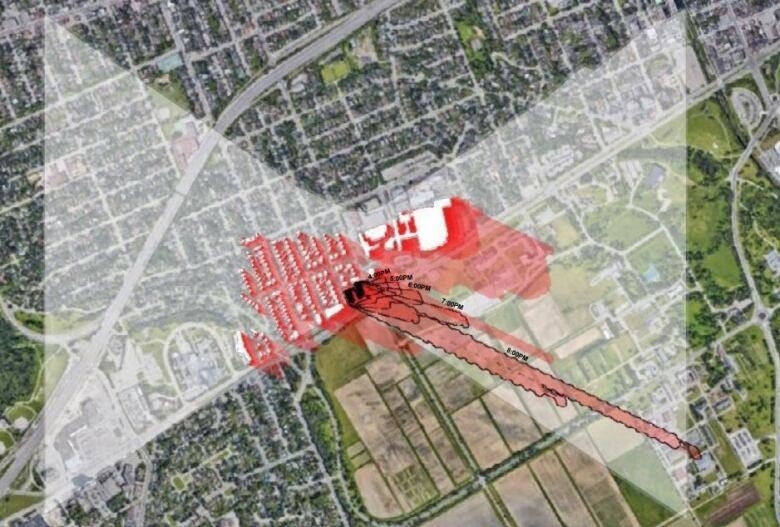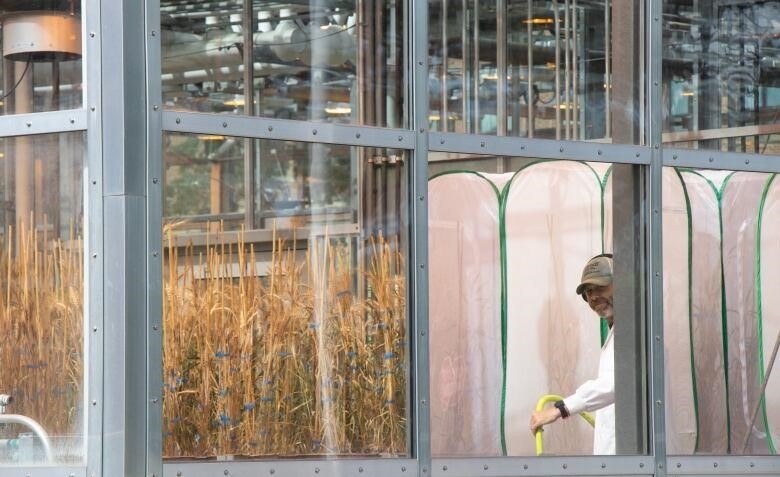
Agriculture Canada says that research fields would be ‘unusable’ because of the shadows cast by the towers on Carling
Agriculture and Agri-Food Canada (AAFC) is warning that two towers planned for the edge of the Central Experimental Farm would block light for important crops and make a large section of its fields “unusable” for most experiments.
Taggart Realty Management wants to build 16- and 27-story towers at 1081 Carling Ave., just west of The Ottawa Hospital’s Civic campus. To do this, it wants to get the height limits at 1081 Carling Ave. raised by a lot. The company says that the towers would have more than 350 apartments for rent, some of which might be affordable at a time when the city is facing a housing crisis.
But in April, two senior AAFC officials wrote a letter to the city asking it to think about how much it would cost to do important research that helps breed crops that can better handle a changing climate.
The problem is that the towers would cast shadows deep into the farm around sunset, which would stop flowers from opening and stop photosynthesis from happening. This would also mess up the data that scientists use to make the food of the future.
Pascal Michel, who is the director general of science and technology for AAFC in the Ontario-Quebec region and signed the letter, said that the research depends on a delicate balance that the towers would upset. The shadows would add a new variable that would make it hard to figure out what the results meant.
In an interview, he said, “At this point, we think it would make it very hard to do any kind of research on those sites.”
“You’re adding uncontrollable noise to the experiment, so the whole research integrity of those data can be called into question…All of this difference makes it hard for researchers to do their work.
WATCH | The planned construction of a tall building will cast shadows on this farm’s research, says the director:
The letter came with a detailed study of how the proposed towers would cast shadows. The study showed that land just southeast of the proposed towers would lose the equivalent of about 70 days of sunlight each year.
The effects get weaker with distance, but the shadows would still make it hard to work at important sandy loam research fields that would lose about seven days of annual radiation.
These fields are a great place to study how drought affects crops. Scientists grow special kinds of wheat, soybeans, barley, corn, and oats there that might be better able to handle the effects of climate change.
Gavin Humphreys, who breeds wheat, said that the shadows would get in the way of his research, which is about everything from disease resistance to surviving the winter.
He said, “There would be problems with how the crop grows, and it wouldn’t be the same as if we were in a farmer’s field where there are no shadows.”

You can’t just move the work, or at least not easily. Michel said that the farm’s different types of soil make it a good place for research. Humphreys said that the fact that it is in the middle of a city with three universities and a lot of educated people is a huge benefit for research.
When asked about Michel’s worries, Taggart Real Estate Management did not answer directly. But in an email to CBC, the company’s president, Jeff Parkes, said that the project is in line with the city’s planning rules about how shadows affect buildings.
He also said that there was a lot of public input, which changed the design, which was sent back to the city twice.

The towers are now smaller than when they were first proposed to be 28 and 22 stories tall. They take a step back toward the small town to the north. Taggart’s architecture firm said that the new design makes the relationship between the two buildings “less intimidating” and that the stronger podium mimics “the scale, texture, and rhythm of the adjacent neighborhood.”
But even the smaller towers are much taller than the height limit of about nine stories on the south side of the site, where an eight-story medical office building is now standing. Taggart wants to tear down that building and a nearby parking garage with even lower height limits.
The head of the Civic Hospital Neighbourhood Association, Karen Wright, said that the proposed towers would be “monolithic.” She thinks that even the new design doesn’t do much to smooth out the sudden change between her house and the one next door.
WATCH | DevThe community association says that eloper should rethink its plans for the “monolith”:
The letter from Michel also makes her worry about the farm. It’s a special thing for her town. She grew up on a farm and loves having a working farm right outside her door.
“It’s not just green space,” she told him. “This is research into agriculture that helps us feed ourselves.”
A national historic site covers the whole farm. But Baseline Road and Carling Avenue are on two sides of it. Both are now considered transit-oriented corridors where the city wants to focus development.
1081 Carling Ave. could be used as a test case. Wright is worried that more tall towers could be built in the future, making the farm even darker.
She said, “I think there are some areas that need to be watched and maybe limited if we want to protect the farm.”
“It’s a large town. Everywhere, things are going to get worse. So, this is a very special piece of land, and I think it might be a good idea to think about putting some rules on it.”

Taggart’s request to change the zoning will be heard by the council’s planning and housing committee on August 16.
Michel said that the more damage a building does to a farm, the higher it is.He said that AAFC is willing to talk to the city in order to find a way to limit the damage.
He said, “Of course, it’s not our job to tell the City of Ottawa how high the building will be.” “But we are definitely committed to working with everyone else to keep the Central Experimental Farm’s historical, cultural, and scientific functions alive.”
